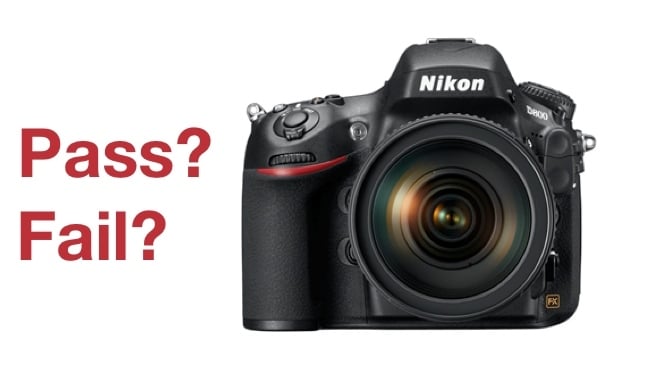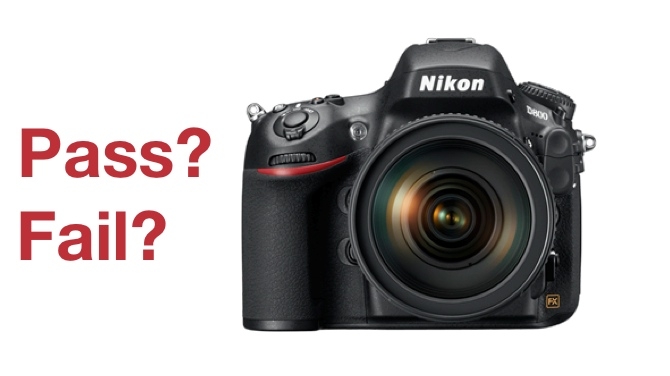
 D800 pass or fail
D800 pass or fail
You may have seen some reaction to the news that the Nikon D800 has "failed" the BBC/EBU tests that indicate whether a camera is suitable for use in serious broadcast productions. But is this the whole story?
The conclusions seem fairly specific. While the camera has good noise, colour and rolling shutter suppression, the final line of the report seems damming:
This camera cannot be recommended for serious programme-making
Here's the conclusion in full:
The camera has very limited controls when in video mode, but has reasonable connectivity, allowing full- resolution external monitoring and recording. Sound facilities are sparse, the internal microphone is adequate for note-taking or guide sound, and the microphone connector is a 3.5mm jack offering only un-balanced input.
The test procedures were as described and recommended by the EBU, in Tech 3335 (http://tech.ebu.ch/docs/tech/tech3335.pdf).Video performance is not really acceptable at 1080p, much less so at 720p. Even though the sensor has 36.8 million photo-sites, it achieves only about 1,355x764, little better than 1,280x720.
Noise levels are very low, even with ISO settings up to 6,400. Significant coloured spatial aliasing is always present, and is clearly visible even on the camera’s LCD display (921k pixels, about 1,176x784). In theory, meticulous control of the shooting style can reduce this but is unlikely to eliminate it, by using only motivated pans together with fairly short depth of field, such that detail out of the focused plane is always soft and therefore can never provoke aliasing. Exposure range is, potentially, as high as 12 stops, although this will be limited by the acceptability of the noise levels near black.
Colour performance is good, and the camera does not respond to infra-red illumination. Motion portrayal is good, the effects of the rolling shutter are nicely suppressed.
This camera cannot be recommended for serious programme-making.
Aliasing
Overall, this looks like a very fair report, and it is absolutely right that a high standard should be set for national broadcasters. For example, the test results talk in length about the problem of aliasing.
Anyone that's worked with either digital audio or video will know quite a lot about this issue, but it crops up in very subtle ways - with not so subtle consequences - in the case of a large-sensor camera that's outputting a low-resolution derivative on the full sensor's image. (Remember that even HD video only has a resolution of around 2.5 megapixels - almost pitifully lower than a modern digital still camera's native resolution).
It is absolutely critical to the quality of the image that the downscaling is done well. "Decimation" is the quick and easy route to downscaling but it needs very careful filtering to avoid serious artefacts. You can see the effects on diagonal lines in the images. It's a big enough problem with still images, but it's much more serious with video, because the artefacts are treated as "detail" by the compression algorithm, soaking up precious bandwidth. Worse still, if these artefacts move, they will be "tracked" by the compression's motion-estimation routines - degrading the image still further.
Why does this happen?
Why does an "expensive" camera like the D800 have these issues? Firstly, because the sensor has a different resolution to the video it is outputting. One to one pixel ratios between sensors and the output image will usually give the best results.
Secondly, the electronics needed to downscale well are expensive and power-consuming. Neither of which are good characteristics for a camera that is not exactly cheap but which would probably not sell if it were two or three times the price - and nor would it be viable if the battery only lasted a few minutes.
So, from this, it would all sound pretty damming.
Except for a couple of things.
It depends how you use it and what it's used for
Nobody would expect the D800 to be used for Downton Abbey (an expensive-looking costume drama popular in the UK). It is much more likely to be used in a context where these negative attributes are less likely to be a problem, or where they can be worked around. It's quite one thing to be horrified at the distinct aliasing visible on a test chart that is designed to show exactly that - but in real life, with relatively random objects and backgrounds, the problems will be much less noticeable.
The second thing is that the tests weren't done with an external recorder. These are devices that take the HDMI output from the camera - uncompressed - and record it to a visually lossless codec like Apple ProRes or Avid DNxHD. These intra-frame codecs are unlikely to exacerbate any existing defects in the video, and - importantly - will be recording in 10 bit 4:2:2 resolution rather than the typical 8 bit 4:2:0 from the camera's internal codec (we don't know this but it is likely that the output from the D800's HDMI is only 8 bit - but there are still advantages to recording in 10 bit because of the additional levels available for use in post production).
So, what does a D800's output look like when used with an external recorder? You'll soon find out - we're testing this exact combination at the moment and will let you know the results as soon as we have them
Tags: Technology


Comments